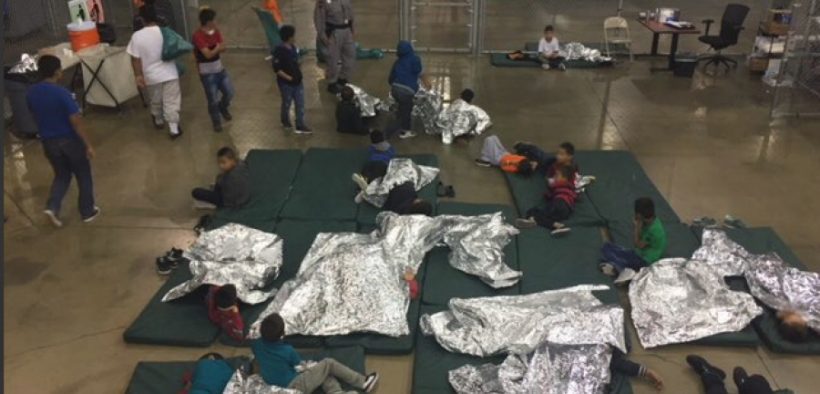Yes, They’re ‘Concentration Camps’

Concentration camps: “A place where large numbers of people, especially political prisoners or members of persecuted minorities, are deliberately imprisoned in a relatively small area with inadequate facilities.”
When asked about her colleague Alexandria Ocasio-Cortez’s use of the term “concentration camps” in reference to detention centers near our southern border, Rep. Ilhan Omar had this to say about the ensuing controversy: “There are camps, and people are being concentrated. This is very simple. I don’t know why this is a controversial thing to say.”
Right-wing media and organizations skewed toward the interests of American Jews quickly lambasted Omar for the perceived insensitivity of her comments as well as lamented her supposed continued use of anti-Semitic imagery. Here’s the problem, though: both she and Ocasio-Cortez are right.
First things first, and sorry to be that guy who cites the dictionary in making a point but here we are, let’s define the phrase. According to Oxford Dictionaries, a “concentration camp” is:
A place where large numbers of people, especially political prisoners or members of persecuted minorities, are deliberately imprisoned in a relatively small area with inadequate facilities, sometimes to provide forced labor or to await mass execution. The term is most strongly associated with the several hundred camps established by the Nazis in Germany and occupied Europe in 1933–45, among the most infamous being Dachau, Belsen, and Auschwitz.
Hmm. “Large numbers of people,” “persecuted minorities,” “deliberately imprisoned in a relatively small area with inadequate facilities.” These qualifiers all seem applicable to the detention centers and other facilities housing families detained at the border and elsewhere in the United States. According to the Department of Homeland Security, close to 45,000 detainees were being held daily on average in the United States as of 2018. What’s more, this figure has risen considerably from the less-than-7,000 detainees daily observed back in 1994 and comes as part of an upward spike concordant with Donald Trump’s political rise. Simply put, these numbers are no accident.
On the persecuted minorities front, um, have you heard the president speak about the Hispanic/Latinx community? As it stands to reason geographically, most of the people in detention in the U.S. are from Mexico, El Salvador, Honduras, and Guatemala. Would conditions in facilities holding immigrants/asylum-seekers be nearly as poor (more on this in a moment) if these people were coming from, say, Norway? Of course not. As evidenced by his defensiveness any time he is challenged by a person of color—especially if that person is a woman—Donald Trump projects his hatred toward members of minority groups and immigrants on the beliefs of all Americans.
Granted, he’s not alone in his racism, xenophobia, and other forms of bigotry; he got elected after all. Still, he’s not speaking for all Americans when he spews his nativist rhetoric buttressed by false or misleading claims and statistics. Like their sheer number as a function of rising trends in immigrant detention, the country of origin of these detainees is highly relevant. Moreover, their demonization obscures the ways in which the U.S. has helped fuel surges in migrants crossing our southern border. In other words, not only do Trump et al.‘s arguments distort the present, but they fail to retrospectively appreciate America’s role in creating the conditions which have led to increases in the number of asylum-seekers from Mexico and Central America. This, too, is no mistake.
And regarding the “relatively small area with inadequate facilities” bit? Yes, this and then some. The story of these detention camps and even for-profit centers and prisons has been one of abject cruelty shown toward detainees. Facilities have been overcrowded well beyond stated capacity. Staffing is frequently insufficient with little guarantee employees are experienced enough or trained well enough to handle their appointed tasks. Adequate health care is often severely lacking if not completely absent, as is supervision of child detainees by adults. Even the availability of blankets, soap, and toothbrushes is of issue. These standards of operation fall below even the auspices afforded to prisoners of war per the Geneva Conventions, and Justice Department immigration attorney Sarah Fabian (among others) should be ashamed of arguing to the contrary.
On these three counts, the detention and separation of families at the border would easily seem to meet the definition spelled out above. Obviously, we’re not to the point of forced labor or awaiting mass execution. This is not Nazi Germany and Donald Trump is not Adolf Hitler. If these are the main distinctions we’re making, however, pardon me for believing we might be missing the forest for the proverbial trees. We should never forget the horrors of the Holocaust nor should we diminish the danger anti-Semitism represents in today’s world. The experience of Jews here and abroad is a unique one and this merits respect.
At the same time, we can recognize that the use of the term “concentration camp,” historically loaded as it may be, is not one made in a flippant manner. As discussed, the conditions of these detention centers would appear to meet the basic requirements delineated by the dictionary definition. Additionally, there is the matter of how urgent the situation is at our southern border. We are in the midst of a humanitarian crisis. Quibbling over semantics risks losing sight of the magnitude of the atrocities being inflicted on people whose only “sin” is crossing the border, in so many cases running from a dangerous situation in their country of origin. It also invites people like Liz Cheney to use Jews purely as political capital, leveraging their suffering amid disingenuous partisan attacks on Democrats.
This is why many refer to border security as a “wedge” issue. Allowing division based on bad-faith discourse is falling prey to the designs of Trump apologists and others itching at the chance to divide and conquer Democrats. We should expect attacks against Ocasio-Cortez and Omar from those on the right who frame the first-year members of Congress as a threat and whose fear (but not fearmongering, to be clear) is welcomed because it exposes the ugliness of their prejudiced antipathy. On the other hand, when those of us on the left and the center-left are effectively providing cover for an administration pursuing a white supremacist agenda and employing genocidal tactics to this end, we should really take stock of our priorities.
In elaborating her position on immigrant detention centers as “concentration camps,” Alexandria Ocasio-Cortez pointed to the opinions of “experts” on the subject. In particular, AOC cited an article for Esquire by Jack Holmes which name-checks journalist Andrea Pitzer, who quite literally wrote the book on concentration camps.
According to Pitzer, the “mass detention of civilians without trial” is good enough for her to satisfy the requirements of a “concentration camp system.” This applies to camps in Nazi Germany, sure, but also Cuba, France, South Africa, the Soviet Union, and in the creation of “internment camps” to hold people of Japanese descent, the United States. Holmes, in speaking to historian Waitman Wade Beorn, whose basis is in Holocaust and genocide studies, also notes how the term is used by historians in a broader sense. According to Beorn, not every concentration camp has to be a death camp. Frequently, the purpose of such a camp is achieved simply by separating one group from another.
At the crux of these camps’ existence are the militarization of the border and the dehumanization of the asylum/immigration enforcement process. For the Trump administration, the large-scale indefinite detention of civilians is the culmination of an intentional effort to depict a spike in border crossings as a “national emergency” and to label asylum-seekers/immigrants as subhuman. It’s an “invasion.” They’re “animals.” Not to beat the dead horse of lore or anything, but this is specific, targeted language. It’s not unintentional, or for that matter, normal.
What’s worse, the longer these facilities operate, the worse the conditions get and the easier it becomes to distance ourselves from the detainees because they are “sick” or because they are “criminals.” This is not purely theoretical, either. Circumstances have worsened. Children and adults alike have died as a result of confinement. And this is exactly what this administration has intended: to make things so bad that families wouldn’t want to come here. As Beorn underscores, it’s not a prison or a holding area or waiting area—it’s a policy. It occurs, no less, at the expense of people who haven’t been, in many cases, charged with a crime. In some instances, even U.S. citizens are being apprehended and detained for days at a time. Those documented occurrences, while perhaps more shocking or unnerving, are rare. For now.
If all this weren’t bad enough, that these facilities are so remote and that they exist in what Beorn describes as a “sort of extralegal, extrajudicial, somewhat-invisible no-man’s land” makes it that much more unlikely these camps will be closed or that visible protests with the ability to meaningfully sway public opinion can be organized on the premises. Holmes points to the prison at Guantanamo Bay as an example in this regard. President Barack Obama repeatedly vowed to close Gitmo, but it “had been ingrained in the various institutions and branches of American constitutional government.”
In the nebulous space where human rights abuses and constitutional protections get overlooked in the name of “national security,” the justifications for these camps staying open can grow more numerous and vague. The names may have changed—George W. Bush and Dick Cheney, meet Donald Trump, Steve Bannon, and Stephen Miller—and so too have the targets of the repression (though with fears of war with Iran ever present, who knows), but the story is very much the same.
Holmes’s piece ends on this sobering note:
In most cases, these camps are not closed by the executive or the judiciary or even the legislature. It usually requires external intervention. (See: D-Day) That obviously will not be an option when it comes to the most powerful country in the history of the world, a country which, while it would never call them that, and would be loathe to admit it, is now running a system at the southern border that is rapidly coming to resemble the concentration camps that have sprung up all over the world in the last century. Every system is different. They don’t always end in death machines. But they never end well.
“Let’s say there’s 20 hurdles that we have to get over before we get to someplace really, really, really bad,” Pitzer says. “I think we’ve knocked 10 of them down.”
We’re already in the midst of a humanitarian crisis and it stands to get worse. Make no mistake: these concentration camps—yes, concentration camps—are a stain on the fabric of America’s moral character, a fabric of which the resiliency is continually being tested under President Trump and which already reveals its share of black marks and tears over its history despite this nation’s overall promise.
We should all own this sad chapter in the saga of our proud nation. And above all others, though his self-absorption and cultivated public image won’t allow acknowledgment on his part, Trump should be tied to the cruel escalation of Clinton-era and Obama-era border policies behind the mass detention of asylum-seekers and immigrants. For a man who loves slapping his name on things, including other people’s successes, his legacy as president should forever be linked with this disgrace.








The incentive for recent migrations remains essentially the same as that which propelled Bronze Age migrations: overpopulation relative to available natural resources. Even as people migrate north from Central America in large numbers, desperate Africans are migrating to Central America!
It is utter nonsense to use the term “sustainable” when the world population has already surpassed by a considerable margin what is actually sustainable by Nature on our Mother Earth.